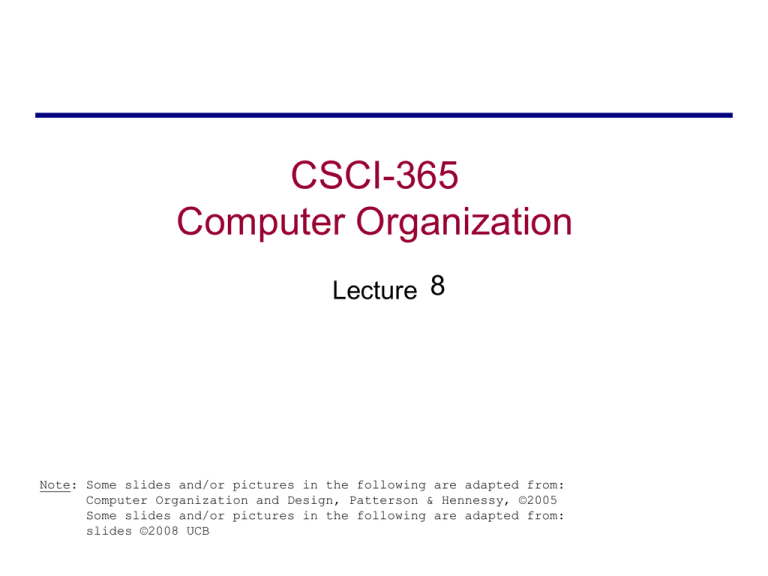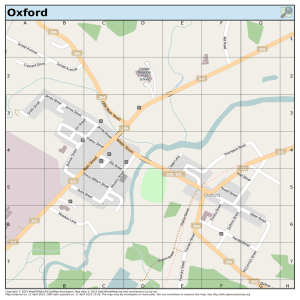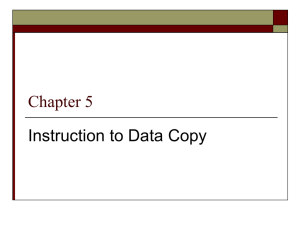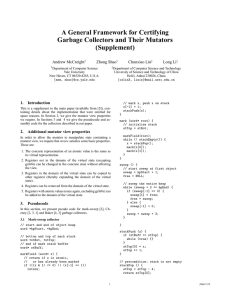
CSCI-365
Computer Organization
Lecture 8
Note: Some slides and/or pictures in the following are adapted from:
Computer Organization and Design, Patterson & Hennessy, ©2005
Some slides and/or pictures in the following are adapted from:
slides ©2008 UCB
The 20 MIPS
Instructions
Covered So Far
Copy
Arithmetic
31
R
31
I
31
J
op
25
rs
20
rt
15
rd
10
sh
fn
5
6 bits
5 bits
5 bits
5 bits
5 bits
6 bits
O pc od e
S ourc e
regis ter 1
S ourc e
regis ter 2
Des tination
regis ter
S hift
am ou nt
O pc od e
ex tens ion
op
25
rs
20
rt
15
o p eran d / o ffset
6 bits
5 bits
5 bits
16 bits
O pc od e
S ourc e
or bas e
Des tination
or data
Im m ediate o pe ran d
or ad dres s o ffs et
op
25
ju m p targ et ad d ress
Instruction
Usage
Load upper immediate
lui
rt,imm
Add
add
rd,rs,rt
Subtract
sub
rd,rs,rt
Set less than
slt
rd,rs,rt
Add immediate
addi
rt,rs,imm
Set less than immediate
slti
rd,rs,imm
AND
and
rd,rs,rt
OR
or
rd,rs,rt
XOR
xor
rd,rs,rt
NOR
nor
rd,rs,rt
AND immediate
andi
rt,rs,imm
OR immediate
ori
rt,rs,imm
XOR immediate
xori
rt,rs,imm
Load word
lw
rt,imm(rs)
Store word
sw
rt,imm(rs)
Jump
j
L
Jump register
jr
rs
Branch less than 0
bltz
rs,L
Branch equal
beq
rs,rt,L
Branch not equal
bne
rs,rt,L
0
0
0
6 bits
1 0 0 0 0 0 0 0 0 0 0 0 260 bits
0 0 0 0 0 0 0 1 1 1 1 0 1
O pc od e
M em o ry word a ddr es s (by te addr es s di vided by 4)
Logic
Memory access
Control transfer
op fn
15
0
0
0
8
10
0
0
0
0
12
13
14
35
43
2
0
1
4
5
32
34
42
36
37
38
39
8
Steps to Starting a Program (translation)
C program: foo.c
Compiler
Assembly program: foo.s
Assembler
Object(mach lang module): foo.o
Linker
Executable(mach lang pgm): a.out
Loader
Memory
lib.o
Compiler
• Input: High-Level Language Code
(e.g., C, Java such as foo.c)
• Output: Assembly Language Code
(e.g., foo.s for MIPS)
• Note: Output may contain pseudoinstructions
• Pseudoinstructions: instructions that assembler
understands but not in machine. For example:
– mov $s1,$s2 or $s1,$s2,$zero
MIPS
Pseudoinstructions
Copy
Arithmetic
Shift
Logic
Memory access
Control transfer
Pseudoinstruction
Usage
Move
move
regd,regs
Load address
la
regd,address
Load immediate
li
regd,anyimm
Absolute value
abs
regd,regs
Negate
neg
regd,regs
Multiply (into register)
mul
regd,reg1,reg2
Divide (into register)
div
regd,reg1,reg2
Remainder
rem
regd,reg1,reg2
Set greater than
sgt
regd,reg1,reg2
Set less or equal
sle
regd,reg1,reg2
Set greater or equal
sge
regd,reg1,reg2
Rotate left
rol
regd,reg1,reg2
Rotate right
ror
regd,reg1,reg2
NOT
not
reg
Load doubleword
ld
regd,address
Store doubleword
sd
regd,address
Branch less than
blt
reg1,reg2,L
Branch greater than
bgt
reg1,reg2,L
Branch less or equal
ble
reg1,reg2,L
Branch greater or equal
bge
reg1,reg2,L
Where Are We Now?
C program: foo.c
Compiler
Compiler
writing
course
Assembly program: foo.s
Assembler
Object(mach lang module): foo.o
Linker
Executable(mach lang pgm): a.out
Loader
Memory
lib.o
Assembler
• Input: Assembly Language Code (e.g., foo.s for MIPS)
• Output: Object Code, information tables (e.g., foo.o for
MIPS)
• Reads and Uses Directives
• Replace Pseudoinstructions
• Allow programmers to associate arbitrary names (labels
or symbols) with memory locations
• Produce Machine Language
• Creates Object File
Assembler Directives (p. A-51 to A-53)
• Give directions to assembler, but do not produce
machine instructions
.text: Subsequent items put in user text segment (machine
code)
.data: Subsequent items put in user data segment (binary rep of
data in source file)
.globl sym: declares sym global and can be referenced from
other files
.asciiz str: Store the string str in memory and null-terminate
it
.word w1…wn: Store the n 32-bit quantities in successive
memory words
Pseudoinstructions
Example of one-to-one pseudoinstruction: The following
not
$s0
# complement ($s0)
is converted to the real instruction:
nor
$s0,$s0,$zero
# complement ($s0)
Example of one-to-several pseudoinstruction: The following
abs
$t0,$s0
# put |($s0)| into $t0
is converted to the sequence of real instructions:
add
slt
beq
sub
$t0,$s0,$zero
$at,$t0,$zero
$at,$zero,+4
$t0,$zero,$s0
#
#
#
#
copy x into $t0
is x negative?
if not, skip next instr
the result is 0 – x
Pseudoinstruction Replacement
• Assembler treats convenient variations of machine language
instructions as if real instructions
Pseudo:
Real:
subu $sp,$sp,32
addiu $sp,$sp,-32
sd $a0, 32($sp)
sw $a0, 32($sp)
sw $a1, 36($sp)
mul $t7,$t6,$t5
mul $t6,$t5
mflo $t7
addu $t0,$t6,1
addiu $t0,$t6,1
ble $t0,100,loop
slti $at,$t0,101
bne $at,$0,loop
la $a0, str
lui $at,l.str
ori $a0,$at,r.str
Example: C Asm Obj Exe
Run
prog.c
#include <stdio.h>
int main (int argc, char *argv[]) {
int i, sum = 0;
for (i = 0; i <= 100; i++)
sum = sum + i * i;
printf ("The sum from 0 .. 100 is %d\n",
}
printf lives in libc
sum);
Compilation:
MIPS
.text
.align 2
.globl main
main:
subu $sp,$sp,16
sw $ra,4($sp)
sd $a0, 16($sp)
sw $0, 8($sp)
sw $0, 12($sp)
loop:
lw $t6, 12($sp)
mul $t7, $t6,$t6
lw $t8, 8($sp)
addu $t9,$t8,$t7
sw $t9, 8($sp)
addu $t0, $t6, 1
sw $t0, 12($sp)
ble $t0,100, loop
la $a0, str
lw $a1, 8($sp)
jal printf
move $v0, $0
lw $ra, 4($sp)
addiu $sp,$sp,16
jr $ra
.data
.align 0
str:
.asciiz
"The sum
from 0 .. 100 is
Where are 7 pseudo- %d\n"
instructions?
Compilation:
MIPS
.text
.align 2
.globl main
main:
subu $sp,$sp,16
sw $ra, 4($sp)
sd $a0, 16($sp)
sw $0, 8($sp)
sw $0, 12($sp)
loop:
lw $t6, 12($sp)
mul $t7, $t6,$t6
lw $t8, 8($sp)
addu $t9,$t8,$t7
sw $t9, 8($sp)
7 pseudo-instructions
underlined
addu $t0, $t6, 1
sw $t0, 12($sp)
ble $t0,100, loop
la $a0, str
lw $a1, 8($sp)
jal printf
move $v0, $0
lw $ra, 4($sp)
addiu $sp,$sp,16
jr $ra
.data
.align 0
str:
.asciiz
"The sum
from 0 .. 100 is
%d\n"
Assembly step 1
•Remove pseudoinstructions, assign addresses
00
04
08
0c
10
14
18
1c
20
24
28
2c
addiu $29,$29,-16
sw $31,4($29)
sw $4, 16($29)
sw $5, 20($29)
sw
$0, 8($29)
sw
$0, 12($29)
lw
$14, 12($29)
multu $14, $14
mflo
$15
lw
$24, 8($29)
addu $25,$24,$15
sw
$25, 8($29)
30
34
38
3c
40
44
48
4c
50
54
58
5c
addiu $8,$14, 1
sw $8,12($29)
slti $1,$8, 101
bne
$1,$0, loop
lui
$4, l.str
ori
$4,$4,r.str
lw $5,8($29)
jal
printf
add
$2, $0, $0
lw
$31,4($29)
addiu $29,$29,16
jr $31
Producing Machine Language
• Simple Case
– Arithmetic, Logical, Shifts, and so on
– All necessary info is within the instruction already
• What about Branches?
– PC-Relative
– So once pseudo-instructions are replaced by real
ones, we know by how many instructions to branch
• So these can be handled
Producing Machine Language
“Forward Reference” problem
– Branch instructions can refer to labels that are “forward” in the
program:
L1:
L2:
or
$v0,$0,$0
slt
$t0,$0,$a1
beq
$t0,$0,L2
addi $a1,$a1,-1
j
L1
add $t1,$a0,$a1
– Solved by taking 2 passes over the program
• First pass remembers position of labels
• Second pass uses label positions to generate code
Producing Machine Language
• What about jumps (j and jal)?
– Jumps require absolute address
– So, forward or not, still can’t generate machine instruction
without knowing the position of instructions in memory
• What about references to data?
– la gets broken up into lui and ori
– These will require the full 32-bit address of the data
• These can’t be determined yet, so we create two
tables…
Symbol Table
• List of “items” in this file that may be used by
other files
• What are they?
– Labels: function calling
– Data: anything in the global part of the .data section;
variables which may be accessed across files
Relocation Table
• List of “items” for which this file needs the
address
• What are they?
– Any label jumped to: j or jal
• internal
• external (including lib files)
– Any data label reference
• such as the la instruction
Assembly step 2
• Create relocation table and symbol table
• Symbol Table
– Label
main:
loop:
str:
Address (in module) Type
0x00000000
global text
0x00000018
local text
0x00000000
local data
• Relocation Information
– Address
0x00000040
0x00000044
0x0000004c
Instr. Type
Dependency
lui
ori
jal
l.str
r.str
printf
Assembly step 3
•Resolve local PC-relative labels
00
04
08
0c
10
14
18
1c
20
24
28
2c
addiu $29,$29,-16
sw $31,4($29)
sw $4, 16($29)
sw $5, 20($29)
sw
$0, 8($29)
sw
$0, 12($29)
lw
$14, 12($29)
multu $14, $14
mflo
$15
lw
$24, 8($29)
addu $25,$24,$15
sw
$25, 8($29)
30
34
38
3c
40
44
48
4c
50
54
58
5c
addiu $8,$14, 1
sw $8,12($29)
slti $1,$8, 101
bne
$1,$0, -10
lui
$4, l.str
ori
$4,$4,r.str
lw $5,8($29)
jal
printf
add
$2, $0, $0
lw
$31,4($29)
addiu $29,$29,16
jr $31
Assembly step 4
• Generate object (.o) file
– Output binary representation for
• text segment (instructions)
• data segment (data)
• symbol and relocation tables
– Using dummy “placeholders” or “guesses” for
unresolved absolute and external references
Object File Format
• object file header: size and position of the other pieces of the object
file
• text segment: the machine code
• data segment: binary representation of the data in the source file
• relocation information: identifies lines of code that need to be
“handled”
• symbol table: list of this file’s labels and data that can be referenced
• debugging information
• A standard format is ELF (except MS)
http://www.skyfree.org/linux/references/ELF_Format.pdf
Where Are We Now?
C program: foo.c
Compiler
Assembly program: foo.s
Assembler
Object(mach lang module): foo.o
Linker
Executable(mach lang pgm): a.out
Loader
Memory
lib.o
Linker
• Input: Object Code files (e.g., foo.o,libc.o for MIPS)
• Output: Executable Code (e.g., a.out for MIPS)
• Combines several object (.o) files into a single
executable (“linking”)
• Enable Separate Compilation of files
– Changes to one file do not require recompilation of whole
program
• Windows NT source is > 40 M lines of code!
– Old name “Link Editor” from editing the “links” in jump and link
instructions
FIGURE B.3.1 The linker searches a collection of object fi les and program libraries to find nonlocal routines used in a
program, combines them into a single executable file, and resolves references between routines in different files. Copyright ©
2009 Elsevier, Inc. All rights reserved.
Linker
.o file 1
text 1
data 1
info 1
Linker
.o file 2
text 2
data 2
info 2
a.out
Relocated text 1
Relocated text 2
Relocated data 1
Relocated data 2
Linker
• Step 1: Take text segment from each .o file and
put them together
• Step 2: Take data segment from each .o file, put
them together, and concatenate this onto end of
text segments
• Step 3: Resolve References
– Go through Relocation Table and handle each entry
– That is, fill in all absolute addresses
Resolving References
• Linker assumes first word of first text segment is at
address 0x00000000
(More on this later when we study “virtual memory”)
• Linker knows:
– length of each text and data segment
– ordering of text and data segments
• Linker calculates:
– absolute address of each label to be jumped to (internal or
external) and each piece of data being referenced
Resolving References
• To resolve references:
– Based on list in each relocation table search for
reference (label) in all “user” symbol tables
– if not found, search library files (for example, for
printf)
– once absolute address is determined, fill in the
machine code appropriately
• Output of linker: executable file containing text
and data (plus header)
FIGURE 2.13 The MIPS memory allocation for program and data. These addresses are only a software convention, and not part
of the MIPS architecture. The stack pointer is initialized to 7fff fffchex and grows down toward the data segment. At the other end, the
program code (“text”) starts at 0040 0000hex. The static data starts at 1000 0000hex. Dynamic data, allocated by malloc in C and by
new in Java, is next. It grows up toward the stack in an area called the heap. The global pointer, $gp, is set to an address to make it
easy to access data. It is initialized to 1000 8000hex so that it can access from 1000 0000hex to 1000 ffffhex using the positive and
negative 16-bit offsets from $gp. This information is also found in Column 4 of the MIPS Reference Data Card at the front of this
book. Copyright © 2009 Elsevier, Inc. All rights reserved.
Problem
•
Link the object files above to form the executable file header. Assume that Procedure A has
a text size of 0x140 and data size of 0x40 and Procedure B has a text size of 0x300 and
data size of 0x50.
Text
Data
Text Size
????
Data Size
?????
Address
Instruction
???????
lbu $a0, ????($gp)
?????????
jal ?????
…
…
??????????
sw $a1, ????($gp)
??????????
jal ??????????
…
…
???????????
(X)
…
…
???????????
(Y)
Static vs. Dynamically linked libraries
• What we’ve described is the traditional way: “staticallylinked” approach
– The library is now part of the executable, so if the library updates
we don’t get the fix (have to recompile if we have source)
– It includes the entire library even if not all of it will be used
– Executable is self-contained
• An alternative is dynamically linked libraries (DLL),
common on Windows & UNIX platforms
– 1st run overhead for dynamic linker-loader
– Having executable isn’t enough anymore!
Where Are We Now?
C program: foo.c
Compiler
Assembly program: foo.s
Assembler
Object(mach lang module): foo.o
Linker
Executable(mach lang pgm): a.out
Loader
Memory
lib.o
Loader
• Input: Executable Code
(e.g., a.out for MIPS)
• Output: (program is run)
• Executable files are stored on disk
• When one is run, loader’s job is to load it into
memory and start it running
• In reality, loader is the operating system (OS)
– loading is one of the OS tasks








